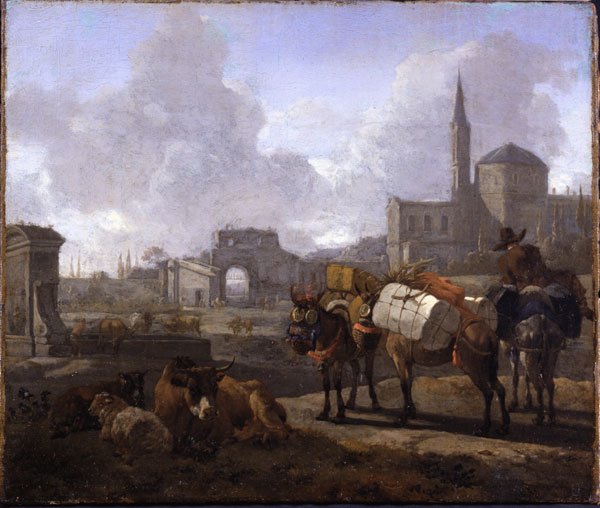

-
Acquisition
Bourgeois Bequest, 1811
-
Accession number
DPG003
-
Artist
Willem Romeyn
-
Date
c.1650
-
Dimensions
35.2 x 41.9 cm
-
Inscription
Signed, bottom right: "W ROMEYN" (WR in monogram)
-
Materials
Oil on canvas
The Dutch artist Willem Romeyn (c.1624-95 or after) has set this scene on the outskirts of an Italian city. Punctuating the skyline are a church with a dome and tall bell-tower, and an arched traveller’s entrance, in soft grey stone. Against a blue, Italian sky, clouds tumble towards the horizon line, while cypress trees punctuate the distant left-hand horizon. In the foreground, Romeyn draws the viewer’s focus to heavily ladened pack donkeys, brass blinkers on their eyes. The hatted rider – seen from behind – seems to begin to make their way towards the city, perhaps having had a brief rest from their travels. Cattle and sheep are seated in the left foreground and also drink from an ancient water trough behind. In his representation of the hinterland of this city, Romeyn captures a sense of the meeting of the town and the countryside, contrasting the transience of the traveller with the imposing permanence of the city.
Romeyn was taught by the Dutch painter Nicolaes Berchem (1620-83) in Haarlem, Netherlands and was a master in that city’s Guild of St Luke (the guild to which painters belonged) by 1646. Like his master, Romeyn specialised in Italianate landscapes. He journeyed to Rome, Italy between 1650 and 1651, where he was known in Italian as ‘Guglielmo Romano’. The draw of Italy can certainly be felt in this Italianate cityscape.

Want to use or download this artwork?
For personal use - Download artwork
For commercial use - Purchase a licence & download on Bridgeman images